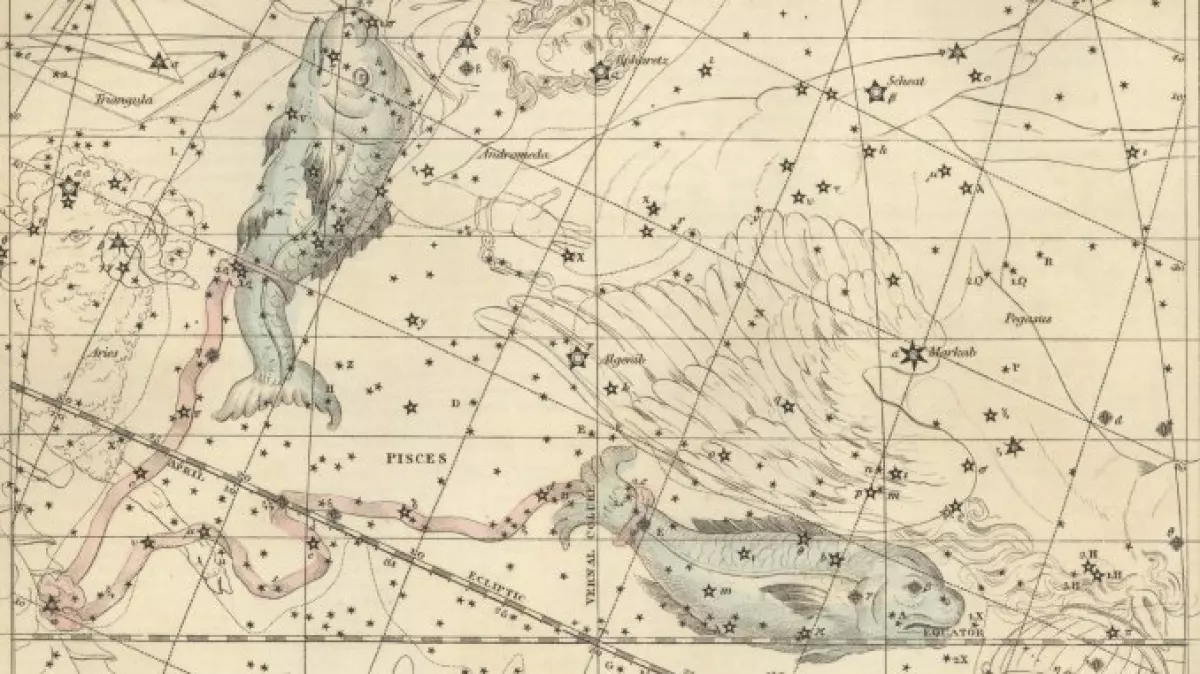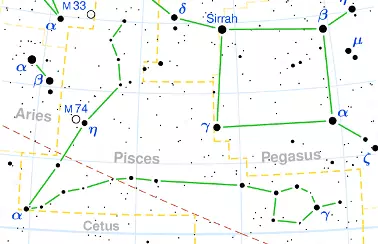 Alexander Jamieson’s Celestial Atlas (1822)
Alexander Jamieson’s Celestial Atlas (1822)
Pisces, the zodiac constellation that represents two fish tied together with a rope, is a mystical and captivating constellation. Despite being the 14th largest constellation, it can be quite challenging to spot in the night sky due to its faint stars. Let's delve into the fascinating mythology, location, and notable features of Pisces.
The Mythology Behind Pisces
The captivating story of Pisces is connected to Aphrodite (Venus) and her son Eros (Cupid). In order to escape the terrifying giant Typhon sent by Gaia (mother earth) to punish the Olympian gods for defeating the Titans, Aphrodite and Eros transformed themselves into fish. They tied each other to a rope to ensure they wouldn't lose each other in the turbulent waters.
A Northern Constellation Located South of Pegasus
Pisces is a northern hemisphere constellation that can be viewed from between +90° and -65° of latitude. It resides in "The Heavenly Waters" region of the sky, which includes a group of nine constellations associated with water. The easternmost fish of Pisces can be found just beneath Andromeda, while the westernmost fish is located below the Great Square of Pegasus, with an imaginary line connecting the two traveling southwards towards Cetus.
The Best Time to Observe Pisces
Pisces is bisected by the ecliptic, making it visible from both hemispheres at different times of the year. In the northern hemisphere, Pisces is best seen in autumn, while in the southern hemisphere, it is best seen in spring. The ancient Greeks also welcomed the appearance of Pisces as a sign of improving weather, symbolizing the end of winter and the beginning of spring.
The Distinctive "V" Shape of Pisces
Covering an area of 889 square degrees in the night sky, Pisces stands out with its distinctive "V" shape. The base of the "V" is formed by the star Alrescha (Alpha Piscium), representing the cord that ties the fish together. The Great Square of Pegasus neatly fits into the "V" of Pisces, making it easier to locate the fish on either side of the square.
The Enigmatic Stars of Pisces
Despite not having any bright stars, Pisces is renowned for its large and massive stars. Let's explore a few notable ones:
-
Kullat Nunu (Eta Piscium): Located approximately 294 light-years away, Kullat Nunu is a yellow giant star with an apparent visual magnitude of 3.62. It is the most luminous star in Pisces, 26 times larger than the Sun and at least 316 times brighter.
-
Gamma Piscium: This yellow giant (G9III) is the second brightest star in Pisces, situated about 138 light-years away. It has an apparent visual magnitude of 3.69 and is ten times larger than the Sun, emitting 61 times more luminosity.
-
Alrescha (Alpha Piscium): As the third brightest star in Pisces, Alrescha is a binary system located 139 light-years from our solar system. With an apparent visual magnitude of 3.82, it consists of two A-type main-sequence dwarf stars orbiting each other every 700 years.
Pisces also boasts other captivating stars, including Fum al Samakah, Upsilon Piscium, Omega Piscium, Omicron Piscium, Iota Piscium, Theta Piscium, Epsilon Piscium, Nu Piscium, Tau Piscium, Chi Piscium, and various binary systems.
Notable Objects in Pisces
Pisces offers a plethora of captivating deep sky objects. Here are a few noteworthy ones:
 Messier 74 (NGC 628)
Messier 74 (NGC 628)
-
Messier 74 (M74, NGC 628): Located approximately 30 million light-years away, M74 is a grand-design spiral galaxy seen face-on. It exhibits clear, well-defined spiral arms and contains around 100 billion stars. With an apparent visual magnitude of 10.0, it remains a challenging observation for amateur astronomers.
-
CL 0024+1654: This massive galaxy cluster, located approximately 3.6 billion light-years away, consists mainly of yellow elliptical and spiral galaxies. Notably, it acts as a gravitational lens, magnifying images of a galaxy located 2.1 billion light-years behind it.
-
Pisces Dwarf (PGC 3792): PGC 3792 is a small, dim, irregular galaxy situated 2.5 million light-years away. With an apparent visual magnitude of 14.2, it still contains several small star-forming regions on its outer fringes. It belongs to the Local Group of Galaxies and is suspected to be a satellite of the Triangulum Galaxy (M33).
The Piscids Meteor Shower
Pisces hosts the Piscids meteor shower, which occurs from August 12th to October 7th, with the peak falling between September 11th and September 20th. During this time, observers can witness a maximum rate of approximately 5 meteors per hour. There is also a suspected northern branch of the Piscids that may peak on October 12th, although its existence is yet to be confirmed.
Pisces in Astrology and Beyond
In astrology, the Sun is said to pass in front of the constellation Pisces between February 20th and March 20th, during the March equinox. However, astronomically, the Sun transits through Pisces from March 12th to April 18th, about a month later, before appearing in the constellation Aries. Pisces is associated with traits such as dedication, kindness, and good humor. It is compatible with Scorpio, Cancer, and Capricorn.
Furthermore, Pisces corresponds to the astrological age we are currently living in. The Age of Pisces commenced in 68 BCE and will continue until 2597, when the Age of Aquarius dawns. Each age lasts approximately 2,150 years, and many believe that different ages bring with them distinct historical events that shape the course of the future.
Discover the enchanting world of Pisces, its celestial wonders, and the deep connections it holds with astrology and human history. Join astronomers and astrologers alike in marveling at the captivating beauty of this constellation.







